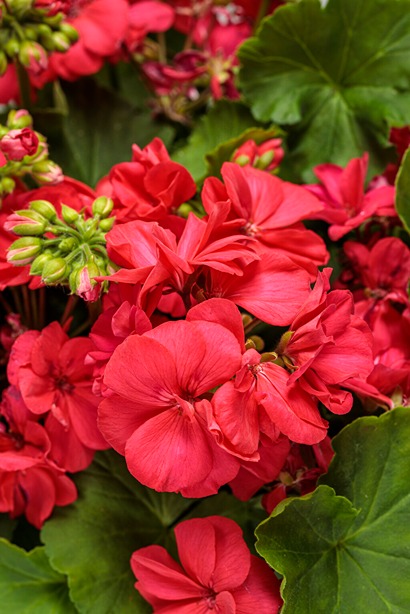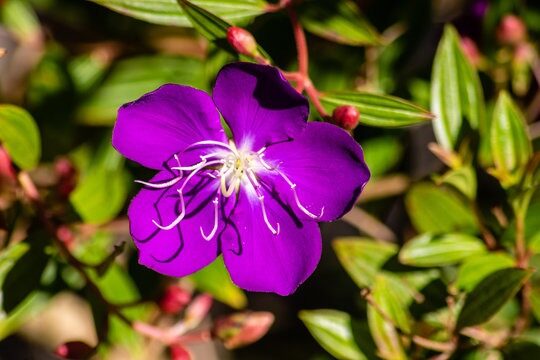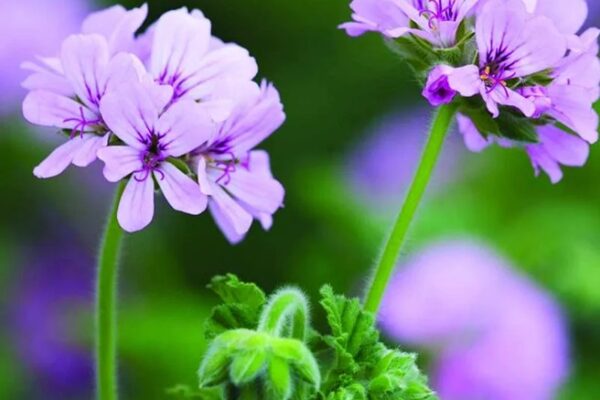6 Dynamic Types of Geraniums for Your Home
If you desire to have an impressive exhibition of vibrant and captivating flowers in your garden, window boxes, hanging baskets, or even on a trellis, cultivating geraniums is the ideal choice. However, a challenge arises due to the vast array of geranium types available. Out of all the variations, the hardy Cranesbill stands as the sole true geranium. The remaining types are technically referred to as pelargoniums and are typically treated as annuals. These pelargoniums can only endure as perennials in regions classified as zones 10 and 11.
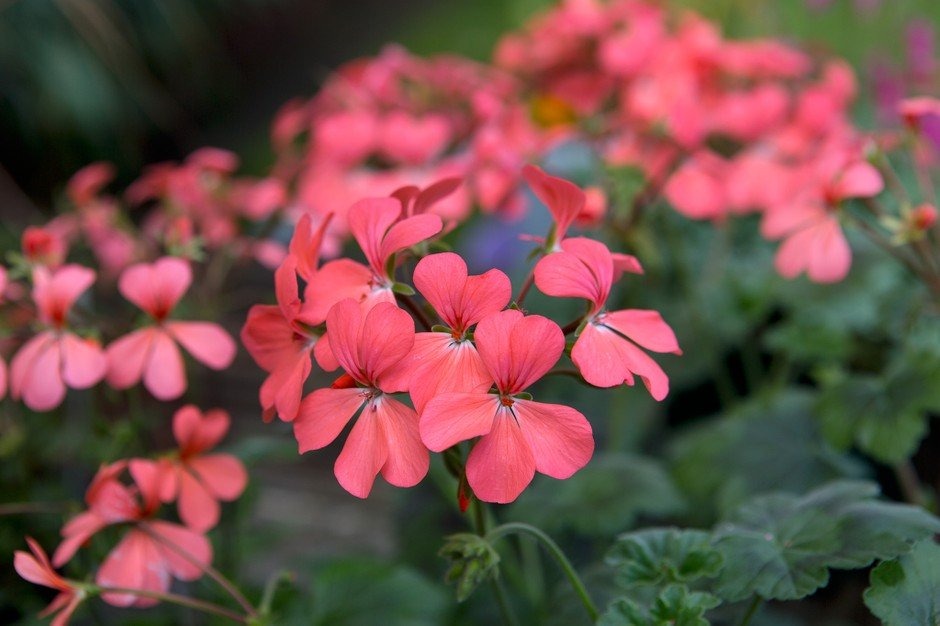
While the colors of geranium varieties exhibit similarities, with certain varieties appearing brighter than others, their flowers typically consist of five petals. Additionally, the leaves of geraniums also possess five lobes, albeit in varying sizes.
The growth patterns of geraniums vary across different varieties. Therefore, it is important to familiarize yourself with the various types of geraniums, their growth habits, and their preferred environments before selecting one solely based on its appealing color. By understanding these factors, you can ensure that you choose a geranium variety that is well-suited to your specific needs and gardening conditions.
Types of Geraniums
Geraniums can be classified into six distinct types, with five of them belonging to the pelargonium family and one being the authentic geranium, known as the Hardy Cranesbill. The pelargonium varieties include zonal geraniums, ivy geraniums, scented geraniums, Regal geraniums (also known as Martha Washington geraniums), and interspecific geraniums, which are hybrids resulting from the crossbreeding of ivy geraniums with zonal species.
1. Hardy Geraniums (Cranesbill)
The Hardy Geraniums, also known as Cranesbill, represent the authentic geranium species. They possess remarkable resilience, capable of withstanding frigid temperatures as low as minus 20 degrees Fahrenheit (approximately -6.5 degrees Celsius).
Distinguishing themselves from other geranium types, the flowers of Hardy Geraniums have a flat saucer-like shape, unlike the layered composition found in other varieties. While they offer a wide range of colors similar to pelargoniums, Hardy Geraniums may not exhibit the same vibrant hues or variegated leaves.
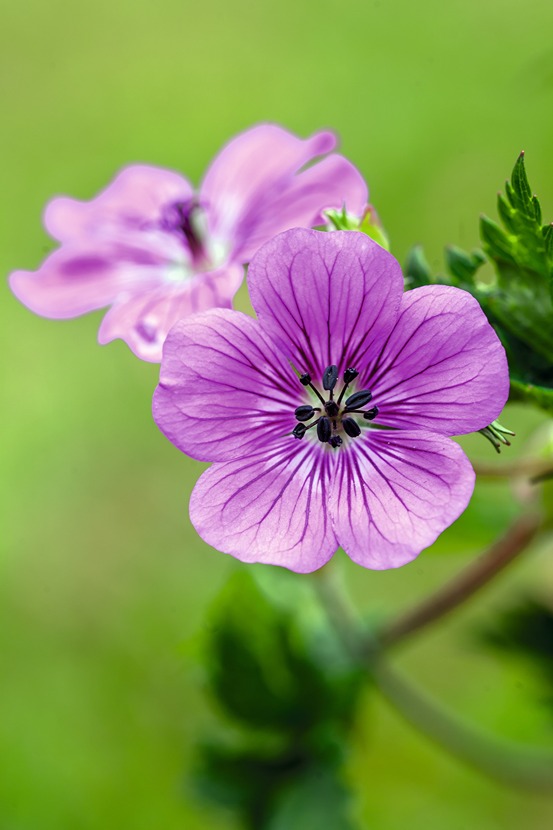
As perennials, these geraniums can be pruned back to a few inches above the soil surface, and without fail, they rejuvenate every spring, bursting back to life with renewed growth. Despite their smaller stature, the low-growing nature of Cranesbill plants ensures the presence of large and brilliant blooms. While other hybridized geranium varieties can reach double their height, Cranesbill typically grows up to 24 inches (approximately 60 cm).
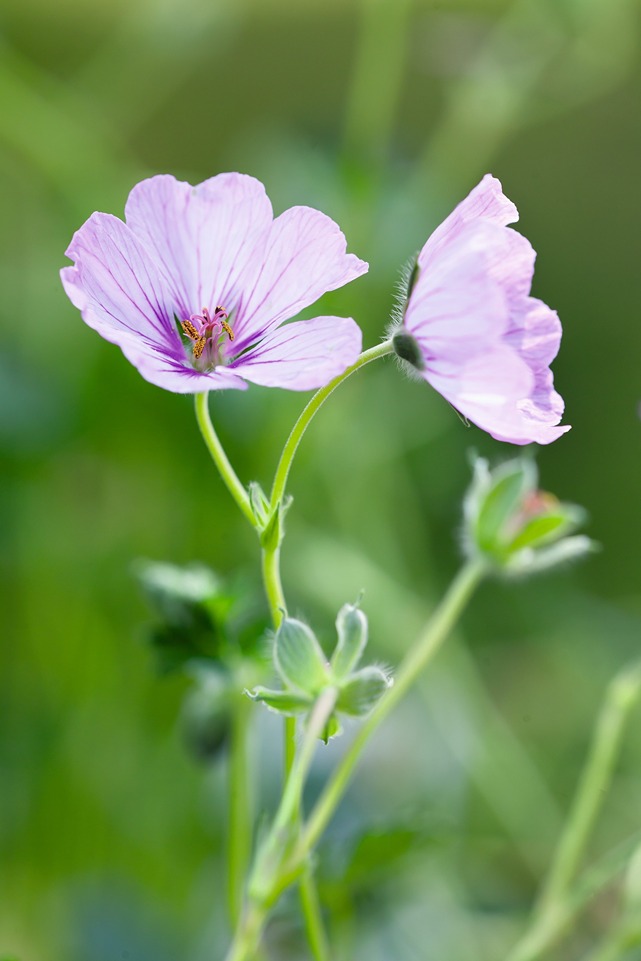
2. Regal Geraniums
Regal Geraniums, also known as Martha Washington geraniums, are characterized by their distinct features. The flowers of Regal geraniums exhibit a captivating color combination, with each blossom displaying two hues. The petals showcase a deep shade in the center, complemented by a lighter color shade around the edges. In newer hybrid varieties, the petals can present two distinct colors, with one shade adorning the upper two petals and a different hue gracing the lower three petals.

Traditional Martha Washington Regal geraniums typically feature a deeper shade on all five petals, with each petal adorned with a lighter-colored edge. These geraniums are renowned as show plants, boasting large and vibrant flowers. Additionally, they showcase various shades of green leaves, with some varieties even displaying variegated foliage.
Regal geraniums labeled as “fancy leaf” geraniums indicate that the leaves exhibit patterns or potentially different colors. Some fancy leaf varieties display dark designer rings spiraling from the center of the leaf, accompanied by a light green border. Others showcase veins of different colors, such as green leaves adorned with striking white veins, creating an eye-catching display.
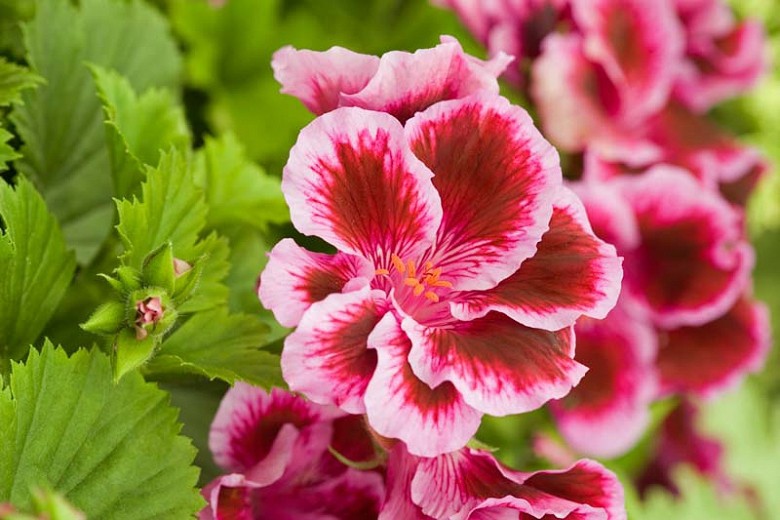
3. Scented Geraniums
Scented Geraniums offer a delightful combination of vibrant colors and aromatic fragrances, making them a perfect addition to your garden seating area. Although the flowers and leaves of scented geraniums are smaller in size, a closer look reveals the opportunity to cultivate a fragrance that suits your preference while enjoying a display of vivid colors.
Popular scents found in geraniums include mint, rose, apple, orange, and lemon, each contributing its unique aroma to the surrounding air. What sets scented geraniums apart is their remarkable ability to tolerate heat, thanks to their self-cooling leaves. These leaves possess specialized glands on their undersides that release aromatic oils, acting as natural coolants. Think of it as scented sweat glands. Intriguing, isn’t it?
Depending on the specific type of scented geranium you choose, you will encounter varying leaf shapes and growth habits. Mint-scented geraniums, for instance, resemble mint plants with slender stems and finely textured leaves that gracefully trail over the edges of containers. On the other hand, fruit-scented geraniums, such as apple geraniums, produce smaller light green leaves and more modestly sized flowers. It’s important to note that scented geraniums are primarily cultivated for their aromatic qualities rather than their showy blooms, which distinguishes them from other geranium types.
Citrus-scented geraniums, particularly the citronella pelargonium, exhibit mosquito-repellent properties. These are particularly desirable around seating areas in gardens or in window boxes, as they help keep windows open without the worry of pesky flies invading your space.
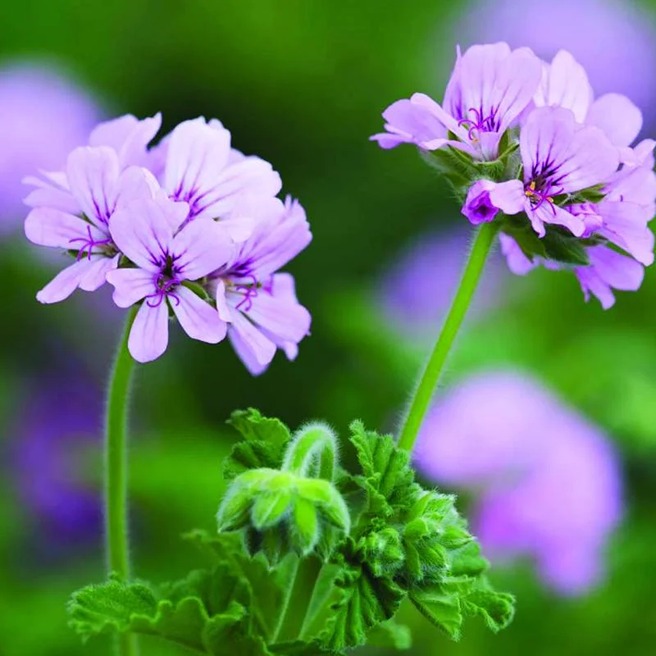
4. Zonal Geraniums
Zonal Geraniums possess unique characteristics that set them apart from other geranium types. These geraniums are exclusively propagated through cuttings, as breeders have specifically bred them not to produce seeds. This intentional breeding approach directs all their energy towards flowering, ensuring a profusion of blooms.
If your primary desire is to add brightness and vividness to your garden or outdoor space, zonal geraniums are an excellent choice. They offer the widest range of color varieties among geranium types, allowing for a diverse and eye-catching display.
Some zonal geraniums are marketed as “fancy leaf” geraniums, much like regal varieties. This indicates that they are pelargoniums with variegated or patterned leaves. These leaf patterns can be truly captivating, with options such as green leaves adorned with white veins. For instance, the Indian Dunes geranium showcases striking red flowers that stand out against dual-toned leaves, which transition from a bronze hue toward the center to a vibrant lime green edging. The presence of patterned leaves adds an exciting backdrop to the blooming flowers, enhancing their visual appeal.
Zonal geraniums are particularly well-suited for window boxes, bedding plants, and containers that adorn patios. These sun-loving bloomers thrive in such environments, providing a burst of color and vibrancy to any space where they are placed.
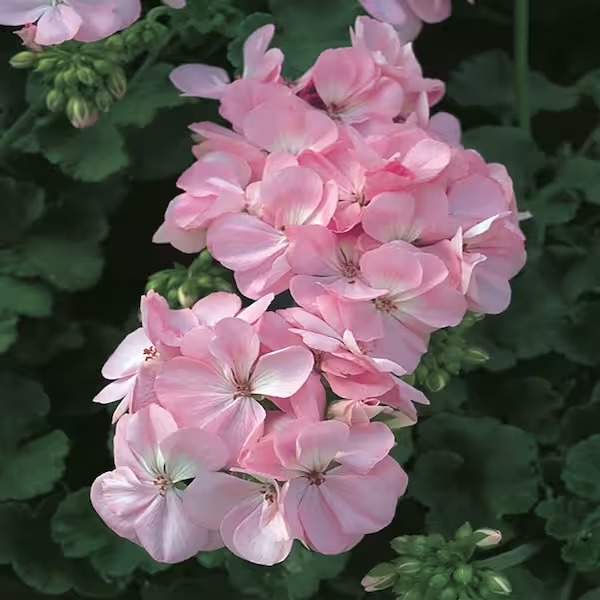
5. Ivy Geraniums
Ivy Geraniums, boasting a diverse selection of over 75 varieties, are characterized by their lush green leaves with five lobes, resembling traditional ivy, and cascading growth habit.
Similar to regal and zonal geraniums, there are trailing varieties of ivy geraniums available, some of which feature patterned leaves as well. These versatile plants can be cultivated in various settings such as window boxes, utilized as ground cover, grown as vines on trellises or walls, or allowed to cascade down walls or garden fences, adding a charming touch to any landscape.
The most popular and widely recognized way to grow ivy geraniums is by utilizing hanging baskets. These plants are specifically well-suited for this purpose, and their cascading nature creates an elegant display when suspended from elevated positions.
One advantageous trait of several ivy geranium varieties is that they are self-cleaning. This term refers to geraniums that do not require deadheading to maintain continuous flowering throughout the season. For instance, the Alpine Ivy Geranium offers options with pink, red, or white flowers and exhibits self-cleaning properties. Another notable self-cleaning variety is the Blizzard series of Ivy Geraniums, which showcases darker hues ranging from blue to dark violet, as well as deep rose-red. The Blizzard series is particularly popular as a mini cascader in hanging baskets, producing a profusion of blooms that can cascade up to 18 inches.
Self-cleaning ivy geraniums are especially suitable for growing in hanging baskets that are displayed at significant heights. This eliminates the need for frequent deadheading, sparing the gardener from the inconvenience of climbing ladders or lowering the basket regularly.
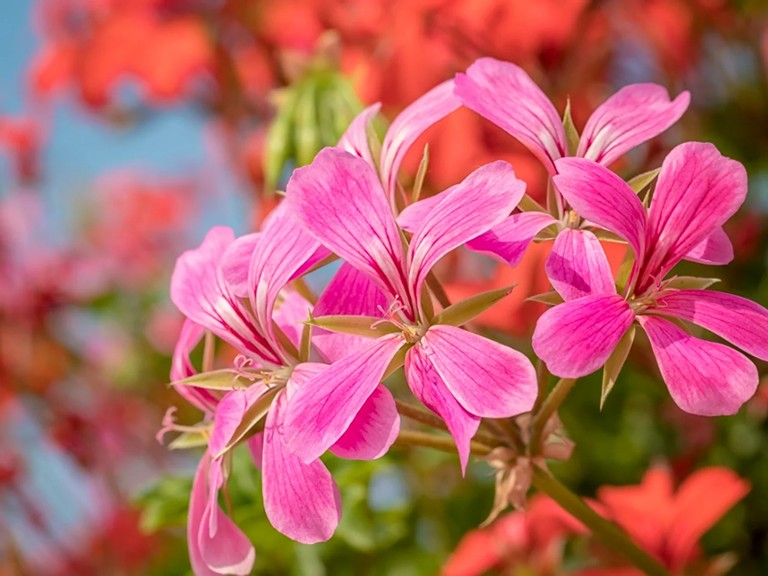
6. Interspecific Geraniums
Interspecific Geraniums represent a unique and rare category of geranium breeds. These hybrids are the result of deliberate crossbreeding between a specific type of ivy geranium and a different species of zonal geranium.
The outcome of this crossbreeding is an intriguing blend known as an ivy-zonal hybrid. These hybrids combine the cascading foliage characteristic of ivy geraniums with the vibrant and colorful blooms of zonal geraniums.
Numerous ivy-zonal hybrid varieties have been introduced, each exhibiting distinctive growth patterns. Among the most popular breeds are Calliope and Caliente. These hybrids showcase deeper shades of reds, purples, and pinks in their flower colors. One notable advantage of these interspecific varieties is that they tend to commence blooming earlier in the season and maintain their blooms throughout, unlike some other hybrids that may not bloom as prolifically.
The Galleria ‘Snowfire’ geranium is another noteworthy interspecific variety, leaning more towards the characteristics of an ivy geranium rather than a zonal one. On the other hand, the Sarita geranium (originally known as the Salsarita) produces larger, single dark red flowers with dark green petals resembling ivy leaves. The leaves of the Sarita geranium are comparatively heavier, making it more suitable for cascading growth rather than training on a trellis.
Although interspecific geraniums generally exhibit smaller flowers, they have a tendency to fill out nicely without sprawling as widely as some ivy geraniums. This characteristic makes them a favorable choice for creating full and compact displays without excessive spreading.
